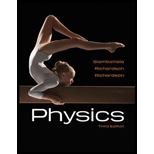
Concept explainers
(a)
The magnitude of the electric field at a point
(a)
Answer to Problem 67P
The magnitude of the electric field at a point
Explanation of Solution
Given that the charge of the inner sphere is
The point under consideration is in between the inner radius of the shell and the sphere. The electric field between the charged sphere and the spherical shell is the same as that due to a point charge at the center of the sphere with same charge as the sphere.
Write the expression for the magnitude of electric field at an outside point of a charged sphere.
Here,
Conclusion:
Substitute
Therefore, the magnitude of the electric field at a point
(b)
The magnitude of the electric field at a point
(b)
Answer to Problem 67P
The magnitude of the electric field at a point
Explanation of Solution
Given that the charge of the inner sphere is
The electric field inside any
Conclusion:
Therefore, the magnitude of the electric field at a point
(c)
The electric field at a point
(c)
Answer to Problem 67P
The electric field at a point
Explanation of Solution
Given that the charge of the inner sphere is
The point under consideration outside the sphere as well as shell. The electric field outside of the spherical shell enclosing the charged sphere is the same as that due to a point charge at the center of the sphere with same charge as the sphere.
Equation (I) gives the expression for the magnitude of electric field at an outside point of a charged sphere.
Conclusion:
Substitute
Electric field from a positive point charge is always diverges away from it. For a sphere of positive charge, the electric field will be radially outward in direction. Hence, here, the electric field is directed away from the center.
Therefore, the electric field at a point
Want to see more full solutions like this?
Chapter 16 Solutions
Physics - With Connect Access
 College PhysicsPhysicsISBN:9781305952300Author:Raymond A. Serway, Chris VuillePublisher:Cengage Learning
College PhysicsPhysicsISBN:9781305952300Author:Raymond A. Serway, Chris VuillePublisher:Cengage Learning University Physics (14th Edition)PhysicsISBN:9780133969290Author:Hugh D. Young, Roger A. FreedmanPublisher:PEARSON
University Physics (14th Edition)PhysicsISBN:9780133969290Author:Hugh D. Young, Roger A. FreedmanPublisher:PEARSON Introduction To Quantum MechanicsPhysicsISBN:9781107189638Author:Griffiths, David J., Schroeter, Darrell F.Publisher:Cambridge University Press
Introduction To Quantum MechanicsPhysicsISBN:9781107189638Author:Griffiths, David J., Schroeter, Darrell F.Publisher:Cambridge University Press Physics for Scientists and EngineersPhysicsISBN:9781337553278Author:Raymond A. Serway, John W. JewettPublisher:Cengage Learning
Physics for Scientists and EngineersPhysicsISBN:9781337553278Author:Raymond A. Serway, John W. JewettPublisher:Cengage Learning Lecture- Tutorials for Introductory AstronomyPhysicsISBN:9780321820464Author:Edward E. Prather, Tim P. Slater, Jeff P. Adams, Gina BrissendenPublisher:Addison-Wesley
Lecture- Tutorials for Introductory AstronomyPhysicsISBN:9780321820464Author:Edward E. Prather, Tim P. Slater, Jeff P. Adams, Gina BrissendenPublisher:Addison-Wesley College Physics: A Strategic Approach (4th Editio...PhysicsISBN:9780134609034Author:Randall D. Knight (Professor Emeritus), Brian Jones, Stuart FieldPublisher:PEARSON
College Physics: A Strategic Approach (4th Editio...PhysicsISBN:9780134609034Author:Randall D. Knight (Professor Emeritus), Brian Jones, Stuart FieldPublisher:PEARSON





